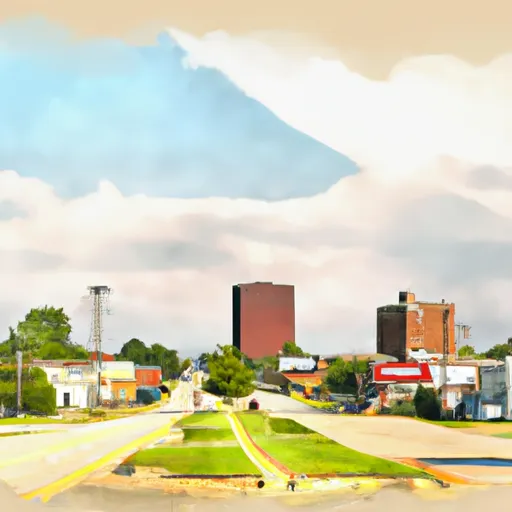-
 Snoflo Premium
Snoflo Premium
Get unlimited access to all our content
With no Ad interruptions! - Start Your Free Trial Login with existing account
Turner
Eden Index
Climate
7.9
•
Recreation
3.5
•
Community
•
Safeguard
4.4/10

Turner, Arkansas is a small community situated in the southeastern part of the state. Known for its picturesque landscape, Turner experiences a humid subtropical climate characterized by hot, humid summers and mild winters. Summers are typically long and warm, with temperatures averaging around 90°F (32°C), while winters are short with temperatures averaging around 45°F (7°C). Rainfall is evenly distributed throughout the year, providing ample water resources for the region.
Hydrologically, Turner benefits from several constituents, including the Little River, which flows through the town. This river serves as a vital water source and offers opportunities for various water-based activities like fishing and boating. The surrounding area is also dotted with numerous ponds and lakes, further enhancing the hydrological resources available to residents and visitors.
Outdoor recreation enthusiasts will find a variety of opportunities in Turner. The lush landscape and mild climate make it an ideal location for camping, hiking, and bird watching. The area boasts several nature trails, parks, and wildlife management areas that allow visitors to immerse themselves in the natural beauty of the region. Additionally, fishing enthusiasts can enjoy angling for bass, catfish, and other species in the numerous water bodies nearby.
What is the Eden Index?
The Snoflo Eden Index serves as a comprehensive rating system for regions, evaluating their desirability through a holistic assessment of climate health, outdoor recreation opportunities, and natural disaster risk, acknowledging the profound impact of these factors on livability and well-being.
Climate Health Indicator (CHI): 7.9
Turner receives approximately
1299mm of rain per year,
with humidity levels near 83%
and air temperatures averaging around
17°C.
Turner has a plant hardyness factor of
8, meaning
plants and agriculture in this region tend to thrive here all year round.
By considering the ideal temperature range, reliable water supplies, clean air, and stable seasonal rain or snowpacks, the Climate Health Indicator (CHI) underscores the significance of a healthy climate as the foundation for quality living.
A healthy climate is paramount for ensuring a high quality of life and livability in a region, fostering both physical well-being and environmental harmony. This can be characterized by ideal temperatures, reliable access to water supplies, clean air, and consistent seasonal rain or snowpacks.
Weather Forecast
Streamflow Conditions
Lower White
Area Rivers
Lower White
Snowpack Depths
Lower White
Reservoir Storage Capacity
Lower White
Groundwater Levels
Recreational Opportunity Index (ROI): 3.5
The Recreational Opportunity Index (ROI) recognizes the value of outdoor recreational options, such as parks, hiking trails, camping sites, and fishing spots, while acknowledging that climate plays a pivotal role in ensuring the comfort and consistency of these experiences.
Access to outdoor recreational opportunities, encompassing activities such as parks, hiking, camping, and fishing, is crucial for overall well-being, and the climate plays a pivotal role in enabling and enhancing these experiences, ensuring that individuals can engage in nature-based activities comfortably and consistently.
Camping Areas
| Campground | Campsites | Reservations | Toilets | Showers | Elevation |
|---|---|---|---|---|---|
| Lake End City Park | 74 | 4 ft | |||
| Lake End Park | 167 | 4 ft | |||
| Clear Spgs Rec Area | 45 | 317 ft | |||
| Natchez State Park | None | 236 ft | |||
| Grand Gulf Military Park | 42 | 238 ft | |||
| Farr Park | 108 | 26 ft | |||
| Chicot County RV Park | 98 | 111 ft | |||
| Lamar Dixon Expo RV Center | 300 | 11 ft | |||
| Lake Bruin State Park | None | 75 ft | |||
| Leroy Percy State Park | None | 108 ft |
Nearby Ski Areas
Catastrophe Safeguard Index (CSI):
The Catastrophe Safeguard Index (CSI) recognizes that natural disaster risk, encompassing floods, fires, hurricanes, and tornadoes, can drastically affect safety and the overall appeal of an area.
The level of natural disaster risk in a region significantly affects safety and the overall livability, with climate change amplifying these risks by potentially increasing the frequency and intensity of events like floods, fires, hurricanes, and tornadoes, thereby posing substantial challenges to community resilience and well-being.
Community Resilience Indicator (CRI):
The Community Resilience Indicator (CRI) recognizes that education, healthcare, and socioeconomics are crucial to the well-being of a region. The CRI acknowledges the profound impact of these elements on residents' overall quality of life. By evaluating educational resources, healthcare accessibility, and economic inclusivity, the index captures the essential aspects that contribute to a thriving community, fostering resident satisfaction, equity, and social cohesion.

